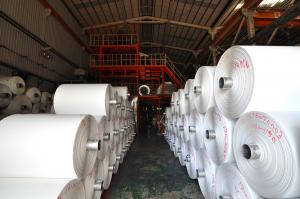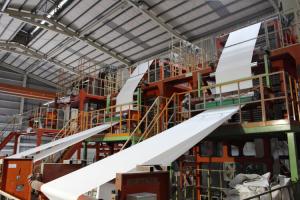Solutions-Oriented Magazine Becomes First to Print on Environmentally- Friendly Stone Paper
Kamp Solutions Magazine adopts innovative solution to inform the world of its groundbreaking potential
LOS ANGELES, CA, UNITED STATES, April 9, 2021 /EINPresswire.com/ -- Jurriaan Kamp, the editor of KAMP SOLUTIONS magazine1, today announced that KAMP SOLUTIONS has adopted one of the solutions-driven innovations it reports on by replacing the pulp paper the magazine is printed on with stone paper.
A solutions journalist reporting on innovative solutions for people and planet since 1995, Kamp began to worry whether his storytelling medium was contributing to the very problems he reported on. 20 trees and 7,480 gallons of water are consumed to produce one ton of the paper his magazines were printed on. Furthermore, the pulp paper industry is the 3rd most energy-intensive of all manufacturing industries, uses 12% of total energy consumed by global industry, and is the 4th largest industrial contributor of greenhouse gases. Kamp adapted by taking his publication online. “As someone who appreciates the feel and experience of a real book, a real newspaper, a real magazine, I always preferred print, though,” explained Kamp.
In 2015, Kamp’s journalistic travels introduced him to a Taiwanese businessman whose family has owned and operated plastic bag factories for decades. To reduce expenses when the oil crisis drove up production costs in the late 1980s, the factory owner, Lung Meng, began mixing stone powder from mining waste in with the plastic. In the process, he discovered he could make paper from the stone. Kamp was intrigued, but the paper was not ready for mass production yet. Over the ensuing decades, Meng perfected the stone paper so that it now surpasses pulp paper in almost every conceivable way. Stone paper requires no trees or water to produce. It can be recycled infinitely, as opposed to pulp paper, which can only be recycled seven to eight times before the fibers disintegrate, and uses no water in the recycling process. Stone paper production uses 85% less energy and emits 60% less CO2 than pulp paper, and the paper itself is more durable and water resistant.
Stone paper has the potential to save our forests and water supply and substantially decrease greenhouse gases if implemented worldwide.
“We can replace half of the world’s paper market with a new material that does not require trees or water. We clean up mining waste, create jobs, and reverse global warming. And—most importantly—monoculture tree farms that deplete the soil and threaten biodiversity can gradually become real forests where nature keeps regenerating life,” said Kamp.
Meng is currently making stone paper in four factories in Taiwan and China. The company has patented the technology in over 40 countries and is actively distributing the licensing technology worldwide, with current licensed plants being built in Romania and Morocco.
Meng has also developed corrugated cardboard made from stone paper that can be used for packaging, the demand for which has risen drastically with the skyrocketing online shopping trend. Because stone cardboard is inherently waterproof, boxes of fruits or vegetables will not attract bugs or mold and packages will not be destroyed by rain. If used to make containers for food, such as milk and juice cartons, the aluminum, wax, and/or plastic layers currently needed to keep those containers water resistant and which are expensive if not impossible to recycle, can be done away with. At comparable volume of production, stone paper cardboard will be up to 50 percent cheaper than regular cardboard. The first stone cardboard factory is slated to go online at the end of 2021.
For more information, visit www.Kamp.Solutions
Mara Quigley
Steve Allen Media
+1 6612558283
email us here
1 http://www.kamp.solutions


